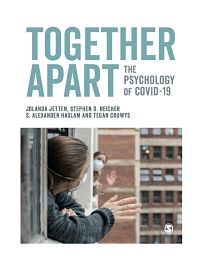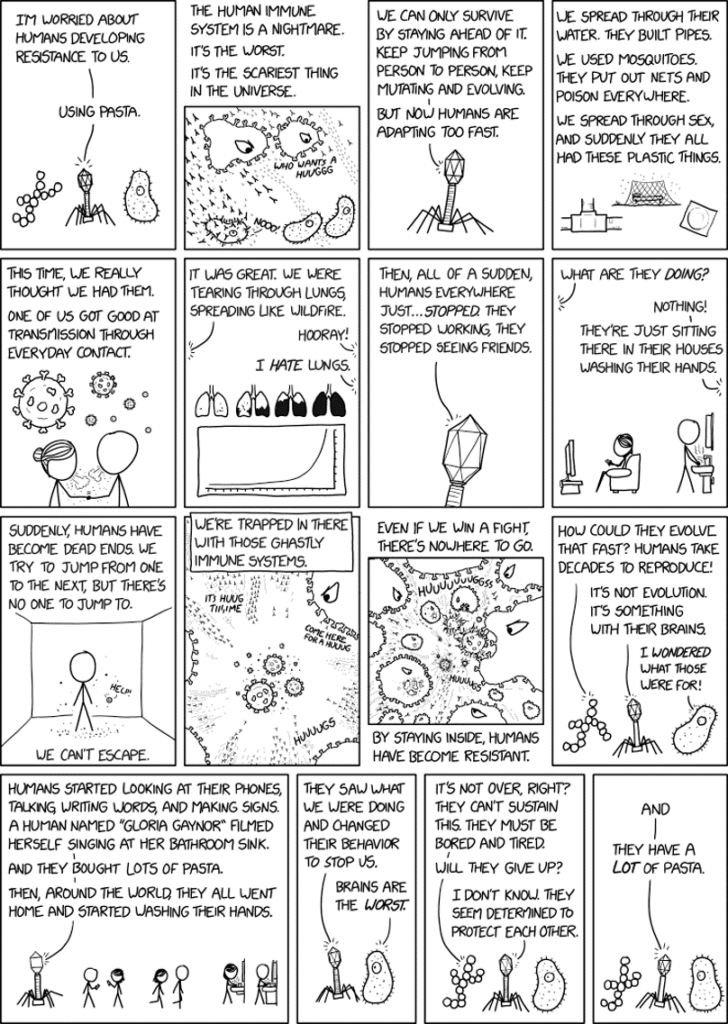Group Threat and COVID: An Excerpt from ‘Together Apart’
The biggest threat to the Territory is clear. It is not us, it’s them.
Western Australian Premier Mark McGowan
We live in a dangerous world. In addition to threats from terrorism, climate change and natural disasters, our sense of danger has become particularly acute as the globe reels in the face of a once-in-a-century pandemic. While the threat may feel unprecedented, people’s reactions to it are not. Indeed, there are remarkable similarities between the ways that people react to threats of various forms and the ways that our group memberships affect our experiences of those threats.
A crisis has a profound effect on the ways in which we draw lines between ourselves and others: between strangers and family, between rivals and allies, and between foreigners and fellow citizens. Whether we draw these lines inclusively or exclusively, one feature of the COVID-19 crisis is that it has brought into sharp focus the groups we belong to: our families, our local community, our country. As we noted in Section A, this means that such threats are generally associated with a heightened sense of shared social identity such that our sense of self is defined to a greater extent by those group memberships. In these times of uncertainty, there is also an enhanced need to understand what being a member of these groups entails and how we should act. How best can I look after my family? What is an appropriate community response? What should ‘we’ (‘we parents’, ‘we practitioners’, ‘we progressives’) be doing?
This chapter addresses these questions and explores how the threat posed by COVID-19 affects our sense of connection to groups, with a focus on how different framings of this threat have different consequences for the group. In particular, research points to important differences between threats that originate from outside one’s own ingroup (i.e., a between-group, or intergroup threat) and threats that originate from within one’s own ingroup (a within-group, or intragroup threat). While intergroup threats tend to increase solidarity, trust and cooperation, intragroup threats tend to undermine such responses (Greenaway & Cruwys, 2019). Though threat has the potential to undermine a collective response to the pandemic, it can also be shaped in ways that promote social solidarity during this tumultuous time. These are issues this chapter explores in the context of COVID-19.

Threats from within an ingroup can undermine solidarity, trust and cooperation
The nature of an infectious disease, especially one that can spread from asymptomatic carriers, is that it is often our close contacts and loved ones who are the source of the threat — meaning that the virus can be understood as an intragroup threat. In the case of COVID-19, it is apparent that some public health messages inadvertently encourage us to be suspicious of our friends, neighbours, and fellow citizens, calling on us to assume they have the disease and are spreading it among us. This has the effect of undermining group ties, as evidenced by a study which investigated threat in the context of Ebola infection (Greenaway & Cruwys, 2015). The study found that U.S. citizens who read about a case of Ebola on U.S. soil identified less strongly as Americans when the case was described as a U.S. citizen than when it was described as a Sierra Leone citizen. Such de-identification can be understood to reflect people’s inclination to ‘psychologically exit’ a group that is under threat, and is especially common among group members who were not strongly committed to the group in the first place (Spears et al., 1997). If this inclination toward ‘psychological exit’ becomes a dominant response, this can lead the group to fracture (Sani, 2008).
Such processes are undoubtedly a barrier to effectively combatting the threats posed by COVID-19. In fighting the virus, people around the world are required to embark upon unprecedented levels of behaviour change that most view as unpleasant. If they do not identify with others, they are unlikely to embark on such change. Furthermore, if an intragroup threat weakens the social fabric of groups, this prevents people from accessing the psychological resources associated with group membership (of a form set out in Chapter 2). For example, if a person does not identify with their neighbours, they are unlikely to go to them for support — even if they are in dire need of it.
Threats from outside the group can bolster solidarity, trust and cooperation
Given the potential divisiveness that can ensue when COVID-19 is framed as an intragroup threat, it is perhaps not surprising that many world leaders have instead sought to frame COVID-19 as an intergroup threat: as a ‘foreign’ disease spread by outsiders. Intergroup threats tend to strengthen people’s commitment to their ingroup (e.g., Castano et al., 2002; Ellemers et al., 1997). For instance, following the 9/11 attacks on the Twin Towers, American university students’ identification with their country increased relative to a baseline taken six months prior (Moskalenko et al. 2006). This in turn makes a difference to people’s behaviour. For instance, social identification enhances people’s trust in fellow group members (Cruwys et al., 2020) as well as their willingness to cooperate in working towards group goals (Haslam, 2001). We have witnessed this in the context of the COVID-19 crisis. As the emergency developed, there was an outpouring of collective solidarity in all parts of the world, as evidenced by the Adopt a Healthcare Worker campaign and a surge in volunteerism (United Nations, 2020). In many parts of the world this elevated concern for the wellbeing of one’s fellow citizens has also been reflected in expanded government welfare policies, with even conservative governments introducing income guarantees that would have been considered radically progressive in previous years (van Leeuwen, 2020).
While leaders may frame COVID-19 as an intergroup threat in order to encourage citizens to respond collectively, this can also have negative consequences for intergroup relations. Indeed, a large body of work has found that the perception of intergroup threat increases intolerance, prejudice, and punishment of outgroup members (e.g., McCann, 2008, Skitka et al., 2006). Unfortunately, intergroup threat can also inspire hostile and punitive reactions, even towards targets that have no objective link with the threat in question. For example, acts of racism towards people of Asian appearance spread across the world even faster than COVID-19 itself (Shimizu, 2020; see Chapter 19).
Inclusive social identities can attenuate perceived threats to an ingroup
It is clear that both intragroup and intergroup threats have unique downsides. While intergroup threat can increase feelings of ingroup identification and ingroup solidarity, it also sharpens the boundaries of who is inside — and who is outside — the group, triggering greater prejudice towards the latter. Conversely, intragroup threat may not directly cause outgroup hostility, but it can undermine ingroup solidarity and cohesion. In turn, this can lead people not only to seek out less group-based social support but also to provide less support to other ingroup members who are in need.
How, then, can we frame a threat like COVID-19 to harness the benefits of intergroup threat without also suffering the negative consequences? There are several approaches to mitigating the downsides of group threat. One that is particularly promising involves framing COVID-19 as an intergroup threat in which the outgroup is not another nation or community of people but rather the virus itself (see Figure 5, and also Section D). Such an approach seeks to emphasise our common humanity as an expanded shared ingroup and has been found to improve intergroup attitudes (Wohl & Branscombe, 2005; see also Chapter 20).

Another approach to preventing the downsides of group threat involves helping people to feel more secure while being buffeted by the winds of fate. More specifically, people need to feel in control (Gerber & Wheeler, 2009). If people feel that they have the capacity to control important outcomes in the face of a threat to their group, they are less likely to react with hostility and outgroup prejudice (Greenaway et al., 2014).
This sense of control can also be collective in nature. Indeed, research suggests that when we believe that our group has control of a situation this can contribute to a sense of personal control, and also help to promote effective responses to threat (Fritsche et al., 2013). In the context of group threats such as COVID-19, messages by governments and health organisations are therefore critical in reassuring individuals that the situation is generally under control. Here, the most effective messages are those that not only provide people with ways to gain control but also tie this to important group goals. The slogan ‘Stay Home. Save Lives’ is a good example of this (Otago Daily Times, 2020).
However, if governments and authorities fail to provide clear messages, they can exacerbate people’s sense that they lack control, and this in turn can intensify negative group-based reactions to the threat. Indeed, poor (or mixed) messaging of this form has been identified as a persistent problem in both the United States (Bennett, 2020) and Brazil (Phillips, 2020). As New York’s governor, Andrew Cuomo, observed “That confusion … adds to the fear and the frustration of people because if [the] government doesn’t know what it’s doing, then people feel they’re really alone and this is really a problem” (Bennett, 2020).
In summary, it is clear that authorities’ messaging is critical in guiding people’s reactions to group threat. Governments and global health organisations have a vitally important role to play in crafting messages that will determine how people perceive and react to the threat posed by COVID-19. The tone they set has the potential to bring people together in a common spirit to respond collectively and effectively (in ways we discussed in Section B). However, if misjudged, these messages have the potential to unleash a wave of distrust directed towards other ingroup members or outgroup members. As we highlight in various chapters in this book, getting this right requires leadership that engenders a sense of common fate and encourages people to join in cooperative efforts to defeat the virus both locally and globally. Indeed, as Figure 5 suggests, this is COVID-19’s worst nightmare.
Explore the section of Together Apart on social (dis)connectedness
Group Threat and COVID| Katharine H. Greenaway
Risk Perception Amid COVID | Tegan Cruwys
Social Isolation Amid COVID | Sarah V. Bentley



























































































